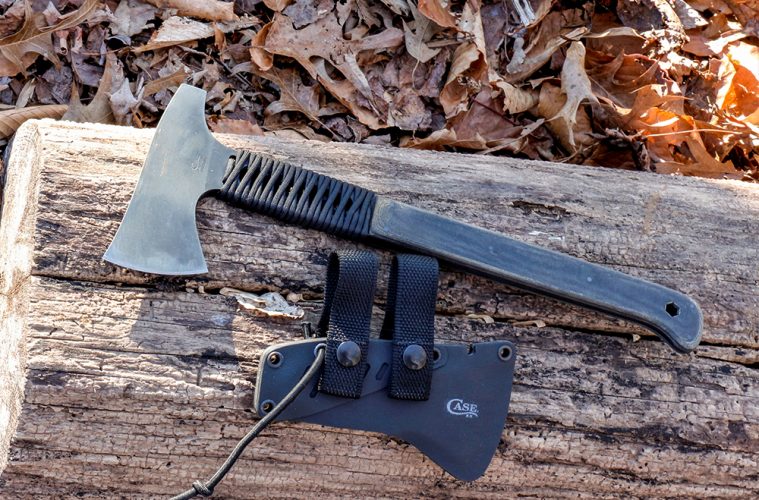HATCHETS, TOMAHAWKS, MACHETES: NOTHING BEATS THESE HEAVY-DUTY, TAKE-ANYWHERE TOOLS
I might be a little close-minded on this, but I prefer to concentrate my knife usage on knife-type chores, such as cutting and slicing. When I need something chopped, I’d rather use a tool kit designed for chopping.
So, more often than not, I have a hatchet, tomahawk, or machete with me when there’s such work to be done.
“Hatchets, tomahawks, and machetes are…made for chopping with the types of steel and heat treatments that make them resilient to lots of pounding.”
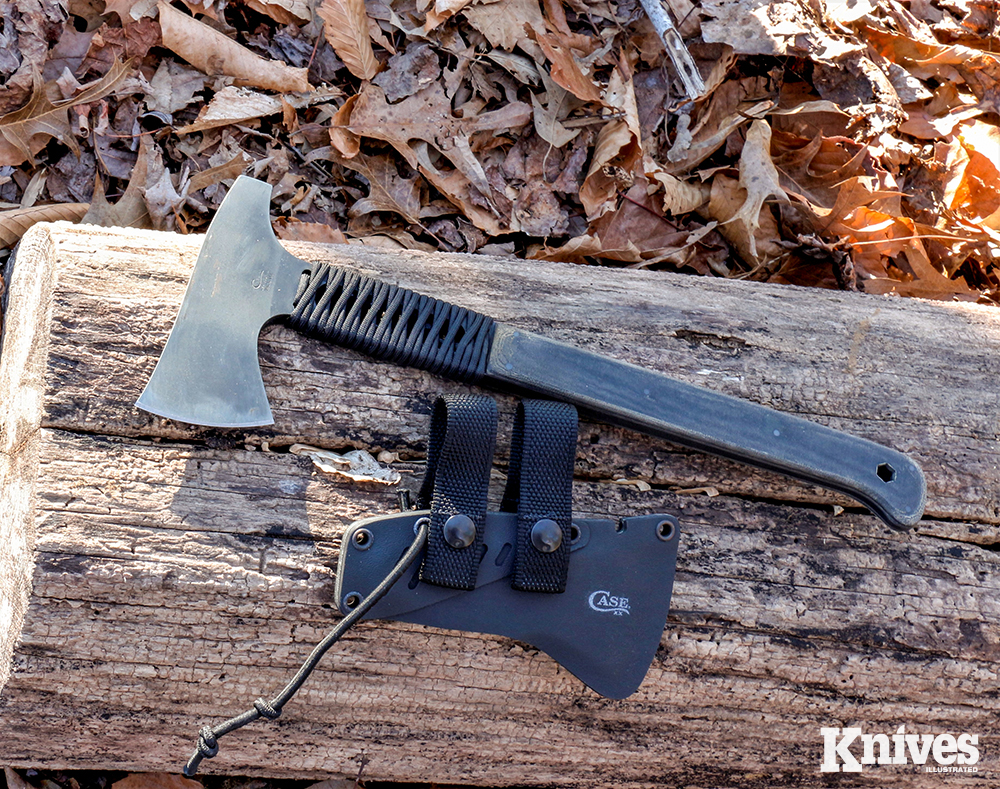
A good hatchet, such as this Case Winkler Pack Axe, can be an indispensable workhorse around the camp and backyard. The sheath allows for multiple carry options on your person or on your pack.
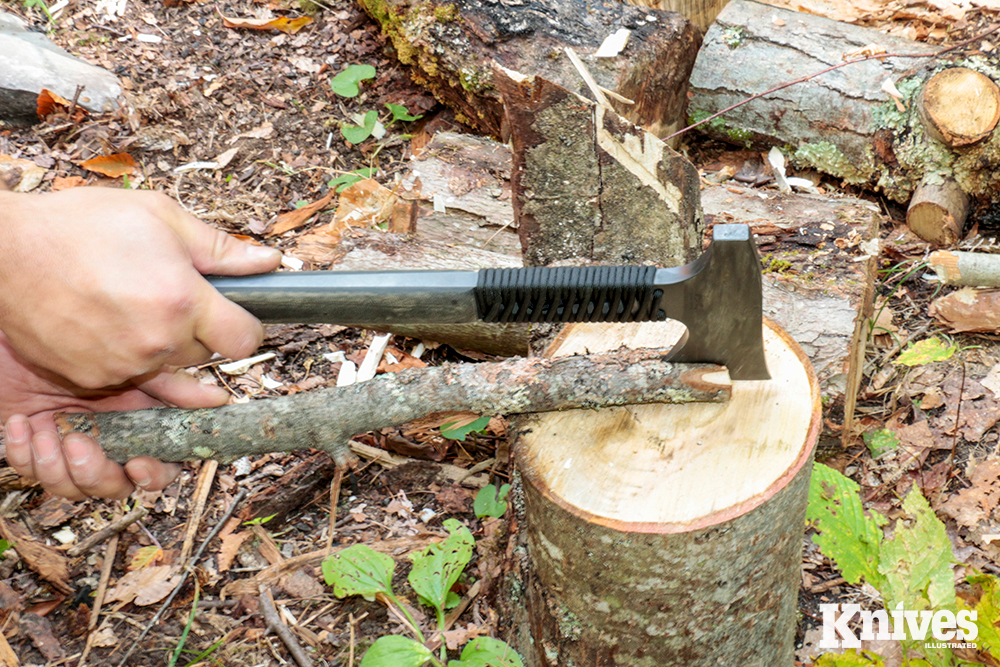
A hatchet can prove invaluable around camp for a variety of chores that could quickly dull or ruin a knife blade.
Three-Tool Kit
I know there’s lots of appeal to the idea of one do-it-all knife. I’ve fallen victim to this notion myself. And truth be told, I own several (OK, many) large knives. I’m all too familiar with the premise:
“What if you have only one knife with you?”
That’s usually how these ruminations begin, followed by the endorsement of some large survival or bushcraft knife. More often these days, I usually answer that question with another:
“Why do you have only one knife with you?”
I’ve never been blindfolded and dropped in the wilderness unexpectedly. Woods wandering is something I can anticipate, and I pack the appropriate gear. Instead of one large knife, I prefer to carry a 3-tool tool kit that consists of a smaller knife, hatchet, and small folding saw.
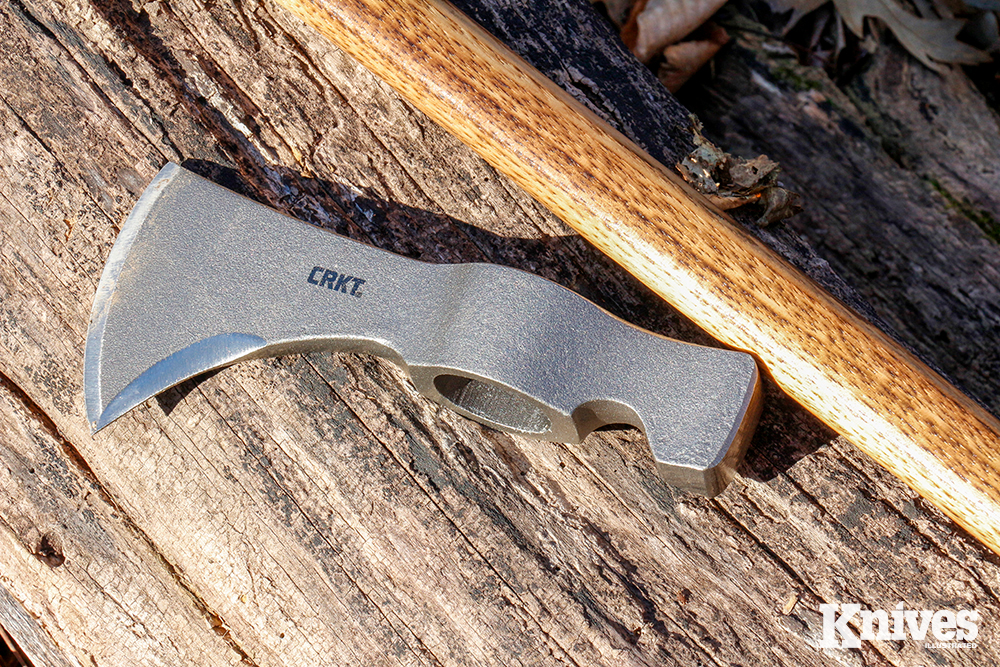
An advantage with a traditional tomahawk is that the head can easily be removed so it can be used separately.
Too heavy, you say? My Outdoor Edge 7-inch Flip n’ Saw weighs 5.8 ounces; my Cold Steel Trail Hawk weighs 23.6 ounces; and my TOPS Skinat fixed blade knife weighs 8 ounces.
So, my three tools tool kit weigh more than twice what my single Becker Combat Bowie weighs (just more than a pound.) You got me there.
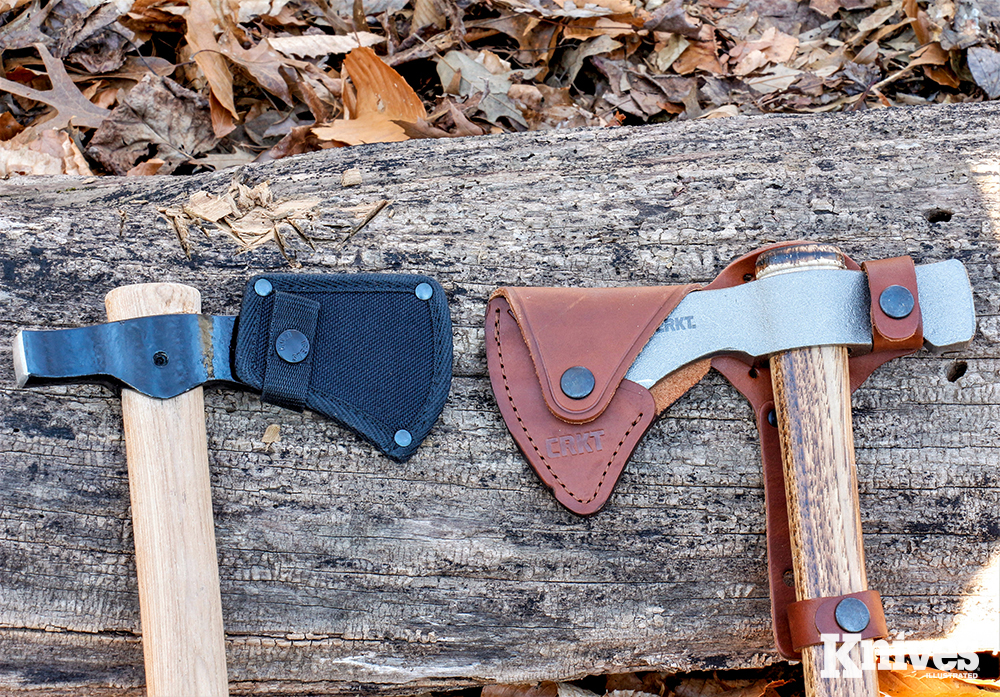
Because you’re more likely to take a portable chopper with you, having a good sheath becomes more important.
But if weight is a significant concern for a particular outing, chances are I’m not going to bring the Becker Combat Bowie either, as much as I like it. I’ll limit myself to my Victorinox Hiker and skip happily down the trail.
Try not to envision that. The point is that the saw blade on that little Swiss Army Knife can do many of the jobs I need done without all the sweaty hacking away at things. When I’m traveling light, I’ll carry light. When I anticipate work, I’ll bring the right tools and tool kit.
Why a Hatchet?
Batoning with a knife gives me a splitting headache. Sorry, I couldn’t resist that. But most knives, with their thin, razor-sharp blades, aren’t built for the abuse. I don’t want to quickly dull my blade or ruin it altogether when I might need it for other important things far from civilization.
Hatchets, tomahawks, and machetes are usually made for chopping with the types of steel and heat treatments that make them resilient to lots of pounding.
“…pick up a good chopping tool, put it through some hard work, and you’ll forget about the if-I-only-had-one-knife debate, at least for a little while.”
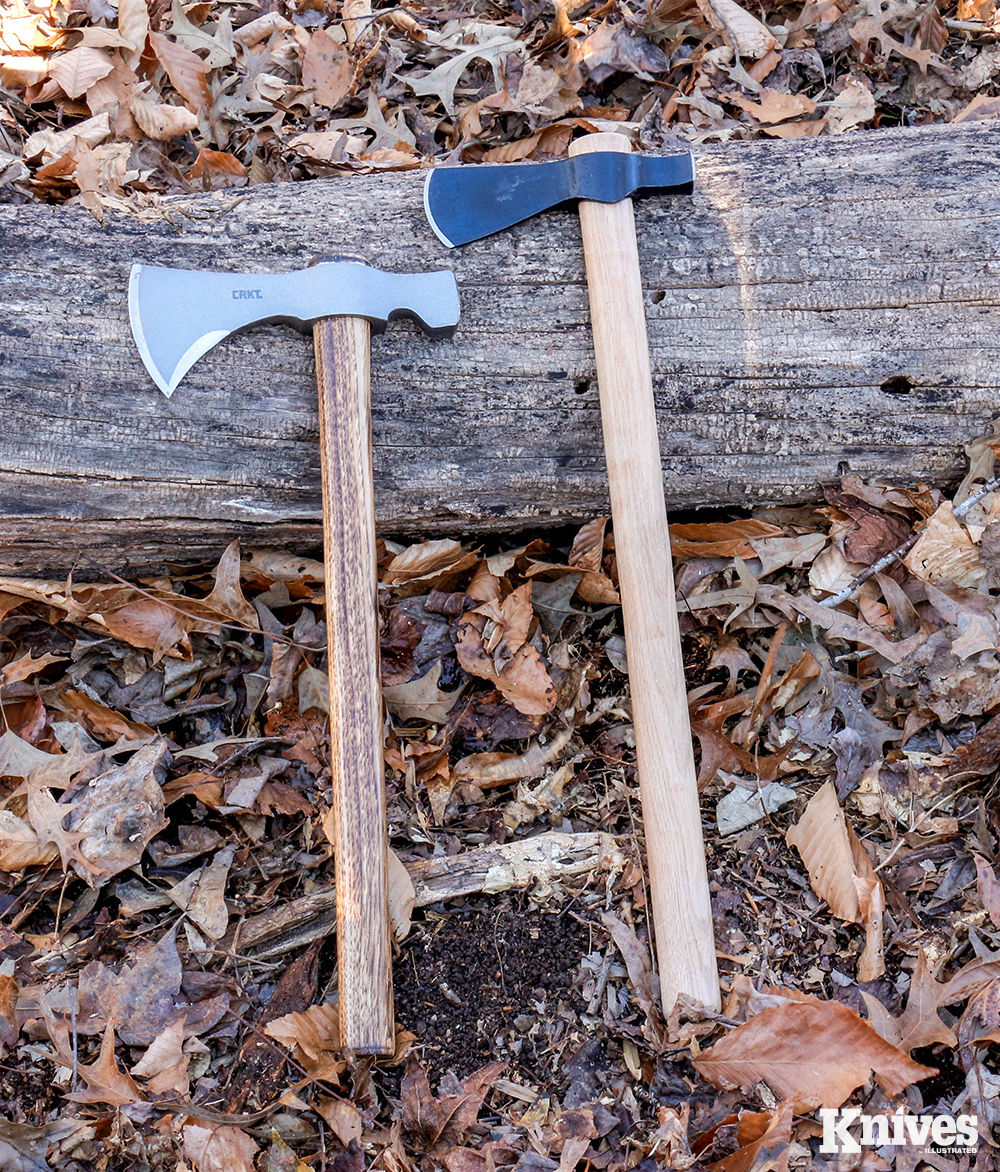
A couple of the author’s favorite traditional tomahawks are the CRKT Woods Chogan T-Hawk (left) and the Cold Steel Trail Hawk.
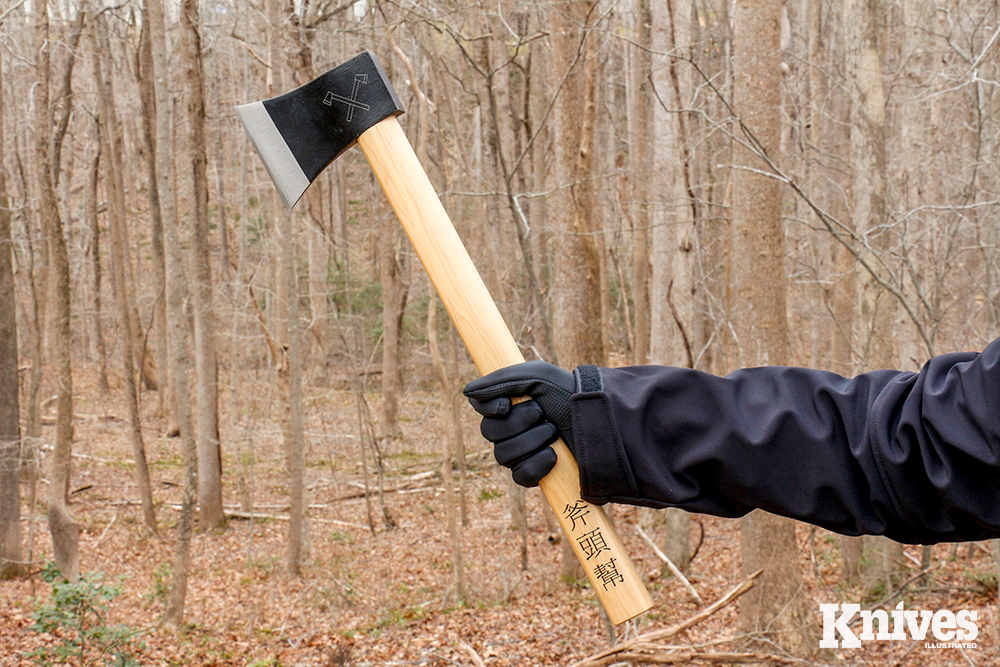
Got zombies? The Cold Steel Axe Gang Hatchet is the very model Rick Grimes carried in The Walking Dead television series. It works very well on wood too.
EFFICIENT AT CHOPPING TASKS
And these tools are more efficient at chopping tasks. So, while I might expend more energy toting these tools initially, I can save a bit of time and energy when it comes to chopping if I have tools and tool kit designed for that.
Building a shelter or a travois, setting up a kettle hanger for the fire, and lightweight splitting of firewood are all accomplished more easily with a hatchet or ‘hawk.
And as a bonus, I get a good pounding tool too, especially if it has a good hammer poll on the back side.
WOOD-HANDLED ‘HAWKS
Traditional, wooden-handled tomahawks can be good choices for a number of reasons. Their heads are usually friction fit to the handles—the handles flare at the top and swinging a tomahawk helps to lock in the head.
A big benefit of this is that the head can be removed usually with little effort. You can use the head as a stand-alone tool for various tasks, including shaving and scraping wood and skinning game. And it’s easier to fashion a new handle in the field should the original one break.
Also, I like that many of these tomahawks feature longer handles. That gives you more leverage and more power in the swing.
Many of the stubby handled hatchets that are billed as “pack hatchets” these days give up too much usefulness for the sake of a couple of ounces with those tiny handles.
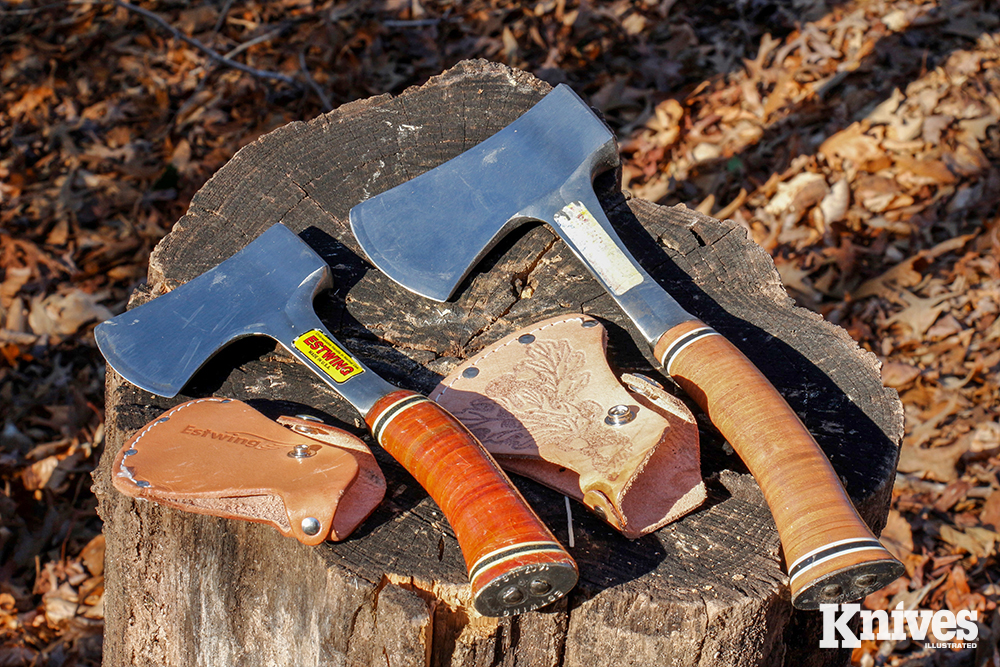
: Old reliables. For price and performance, it’s hard to beat the Estwing Sportsman’s Axe, available in two sizes. These will take a lifetime of hard use.
REASONABLE IN PRICE
Add to the list of pluses the fact that most of these wooden-handled tomahawks are very reasonable in price. Two I’ve come to like are the Cold Steel Trail Hawk and the CRKT Woods Chogan T-Hawk.
The Trail Hawk features a 2 ¼-inch edge, 22-inch handle for lots of power and reach, and a hammer poll for added utility. It sells for $44.99. The T-Hawk was designed by Ryan Johnson of RMJ Tactical, maker of some excellent high-end ‘hawks.
It has a 19-inch handle, slightly larger 3.5-inch blade, hammer poll, and sells for a suggested $69.99.
Incidentally, new for CRKT is the Berserker tomahawk, also designed by Johnson. This is more of a Viking-style ‘hawk with curved beard and a 4.65-inch edge. It has an MSRP of $74.99.
ALL-STEEL APPEAL
The obvious advantage with an all-steel hatchet or ‘hawk—one where the head and handle consist of one continuous piece of steel—is that there’s little worry about handle separation.
These might have leather, Micarta, or rubber over the steel, or they might be wrapped with paracord for a more sure grip. You don’t want it to be too grippy, however.
If you have tender hands, such as those of a writer or other keyboard ninja, blisters are almost assured.
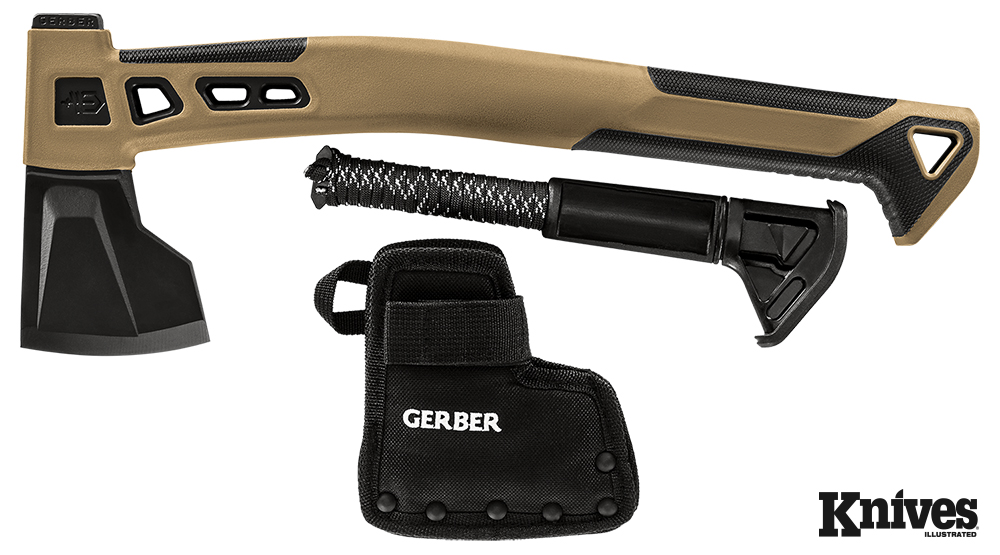
One of the newest chopping tools in the Gerber lineup is the Bushcraft Hatchet that features a gear storage stick in the handle. A larger model, the Bushcraft Axe, has just been introduced too. Gerber photo
CRAFTSMAN HATCHET
Early in my marriage about a thousand years ago, my wife gave me a Craftsman hatchet as a gift.
Craftsman was a brand known for hand tools, not knives, but as unlikely as you might think, this hatchet came with an edge that was sufficiently sharp and a rubber handle over the steel. This actually improved over the years as the handle wore down and became less grippy.
I’ve examined other hardware department hatchets over the years, but never found one as good. When the local Sears store was closing, I went and bought a second hatchet before they were gone.
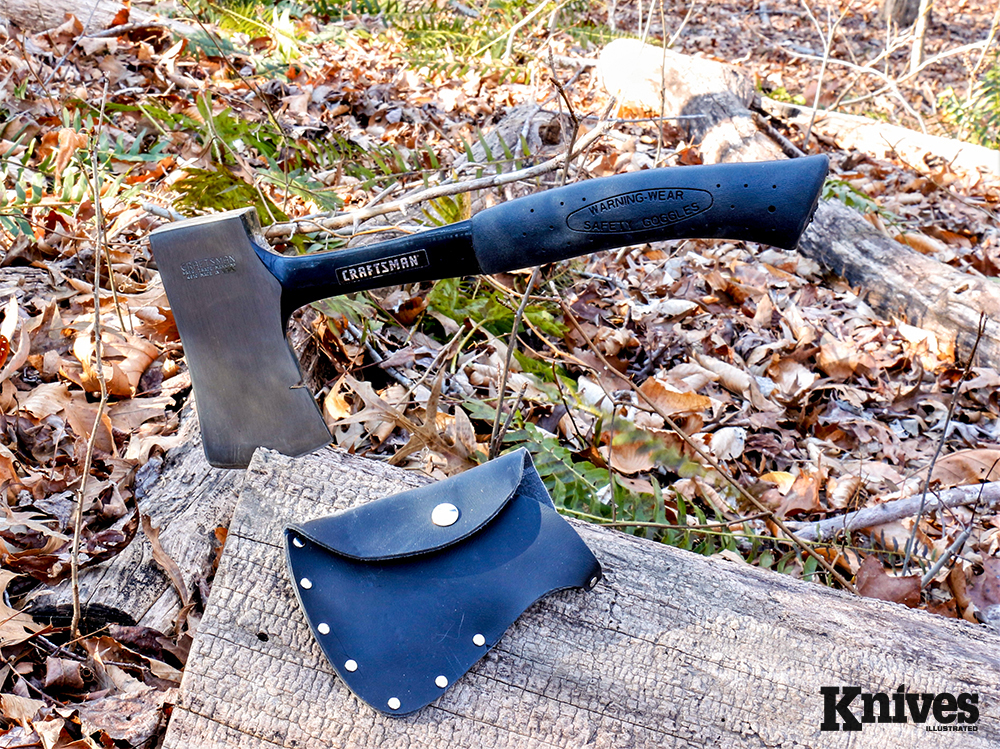
The author used a Craftsman all-steel hatchet for many years. When the local Sears store was closing, he bought this second one before they were all gone.
The old reliable models of all-steel hatchets are the Estwing Sportsman’s Axes. There are two models with stacked leather grips: one 12 ½ inches long with a 2.75-inch edge and one slightly larger that’s 13 ½ inches long with a 3.25-inch edge.
I own both and I’m not giving them up. I can chop and pound with these with little worry about damaging them as I would with a knife. No, these aren’t custom pieces, but for a real-world price of about $35, you can’t go wrong.
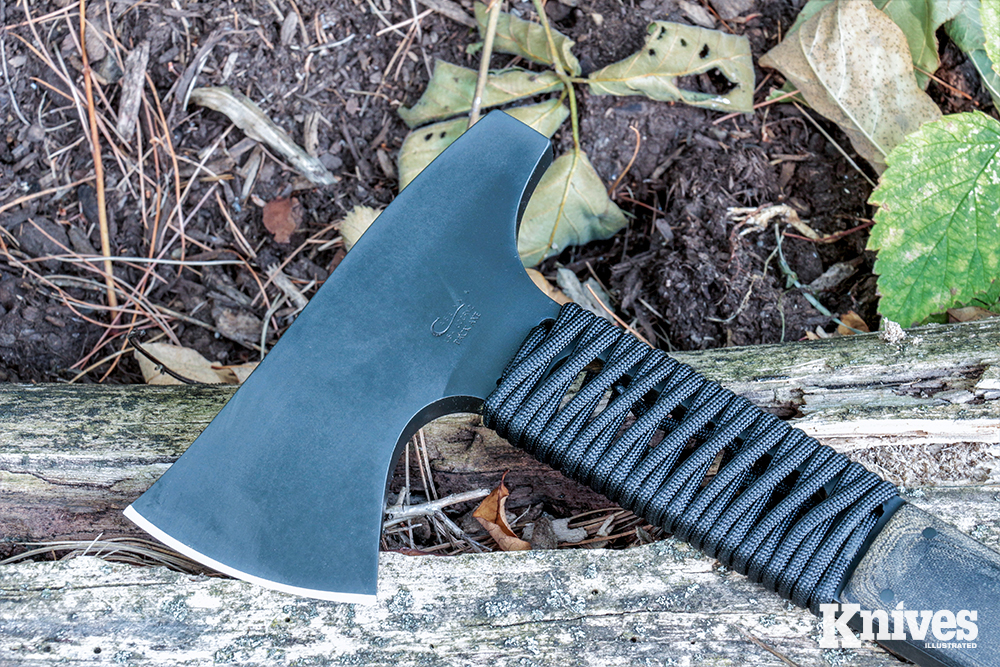
The author’s current favorite is the Case Winkler Pack Axe, a top-quality tool that balances size and performance.
CASE WINKLER PACK AXE
As much as I love the tools I’ve already mentioned, I have to say that my current favorite is the Case Winkler Pack Axe. This one is much pricier at a suggested $499.99, but it’s fantastic. It’s a product of the collaborative efforts of W.R. Case & Sons and Winkler Knives with design input from military veteran Kevin Holland.
It’s made of a single 3/8-inch-thick piece of 80CrV2 and has canvas laminate grip panels that provide the right amount of texture. It also has a paracord wrap just under the head, excellent when choking up on the handle and using it one-handed.
OTHER TOOLS, OTHER TASKS
In the past I’ve put my Gerber Camp Axe to good use. This model has a 17.5-inch fiberglass-reinforced nylon handle, good for those of us who prefer long handles.
I initially was worried about how it would hold up, but I’ve never had any issues with it. It has been replaced by Gerber’s Freescape models with the bug-guts green handles that are offered in several sizes.
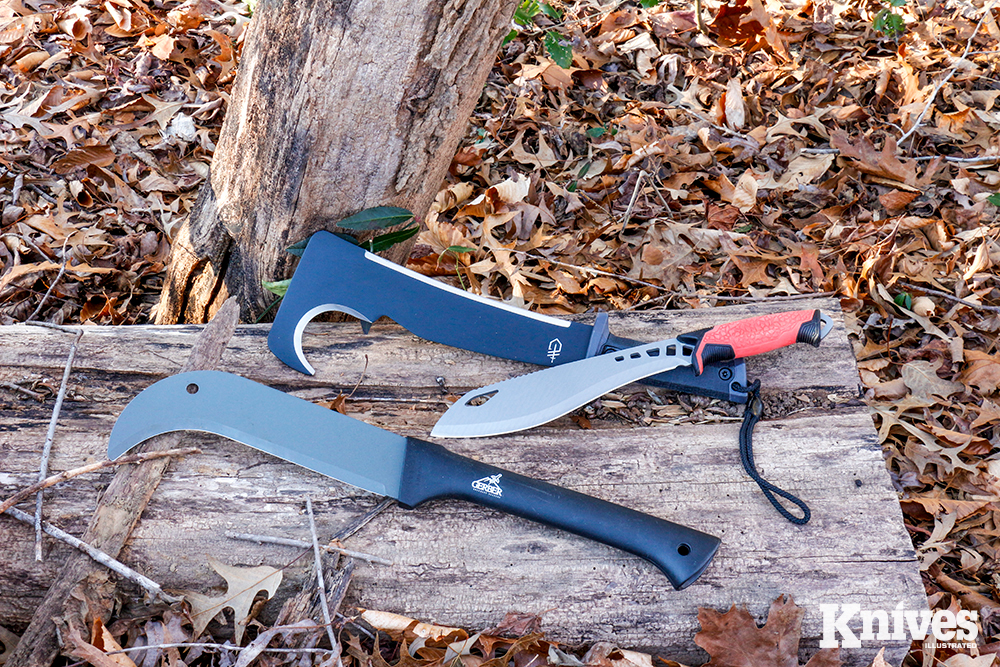
Not just hatchets and tomahawks. A selection of Gerber tools, including the Gator Machete Pro (top), the company’s take on the Woodsman’s Pal; the Versafix Pro; and the Brush Axe, now sold under the parent company Fiskars brand.
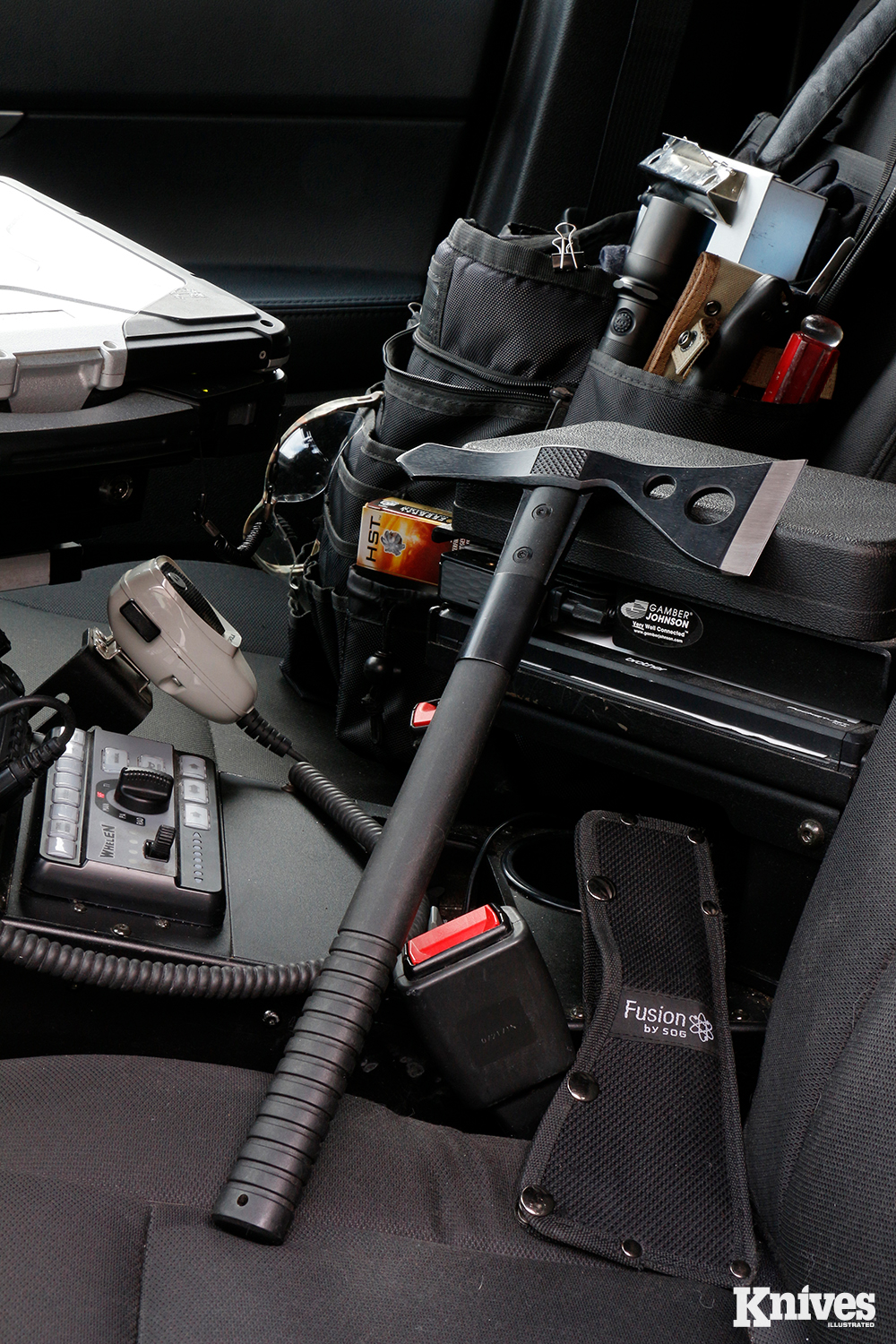
A tomahawk has uses far beyond the woods. The author carried this SOG Tactical Tomahawk in his patrol bag as an extrication tool for many years when he was a police officer.
SURVIVAL GEAR
Newly introduced are the Gerber Bushcraft Hatchet and Bushcraft Axe. Their overall lengths are 15 ¼ and 26 ¼ inches, respectively. The Steel head extends partially into the handle to protect against over-strikes.
The rest of the handle on each is hollow and includes a removable, water-resistant gear storage compartment suitable for small survival gear. The MSRP will be $59.99 for the hatchet and $79.99 for the axe. Those are on my list.
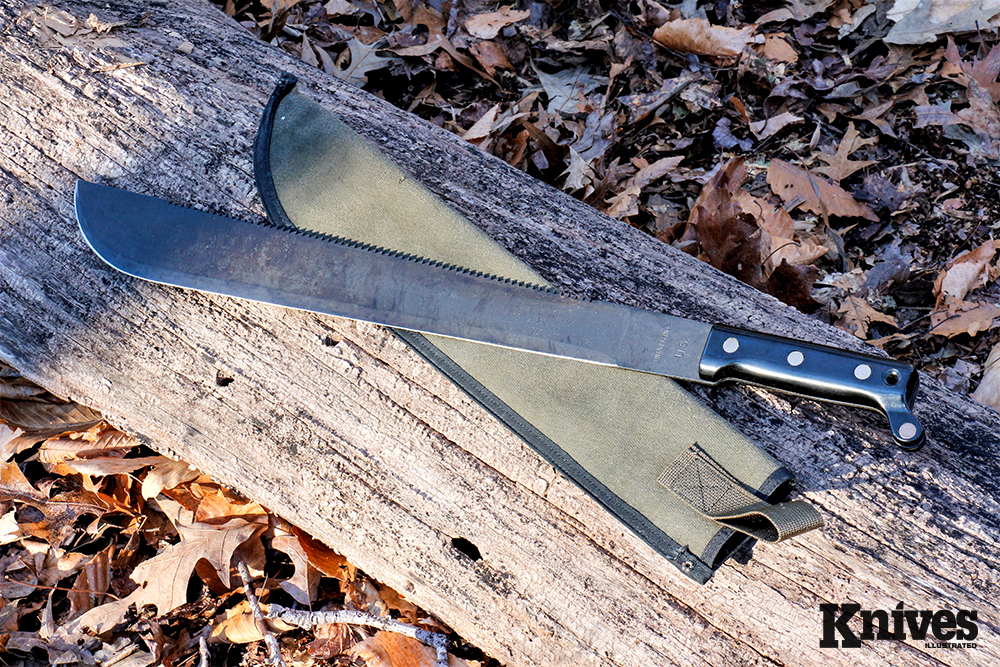
This Ontario 1-18 Military Machete is a model Ontario has been making for more than 60 years. It’s still a top choice.
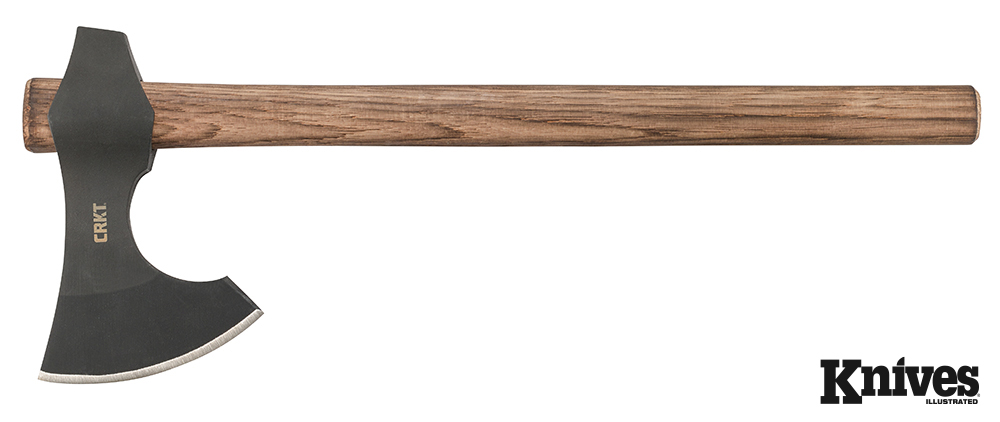
The Berserker is the newest tomahawk in the CRKT lineup. Like the Woods Chogan T-Hawk, it was designed by Ryan Johnson of RMJ Tactical. CRKT photo
The usefulness of hatchets and tomahawks doesn’t end when you step out of the woods. For years, I regularly carried a SOG Tactical Tomahawk in my patrol bag as an extrication tool when I was a police officer. And my compact Browning Shock ‘N Awe tomahawk is strategically placed for last-ditch home defense.
Both have spikes instead of hammer polls. Need to get into a drug dealer’s car trunk? No problem. Need to chop an emergency exit through an interior wall when a building’s on fire? Piece of cake.
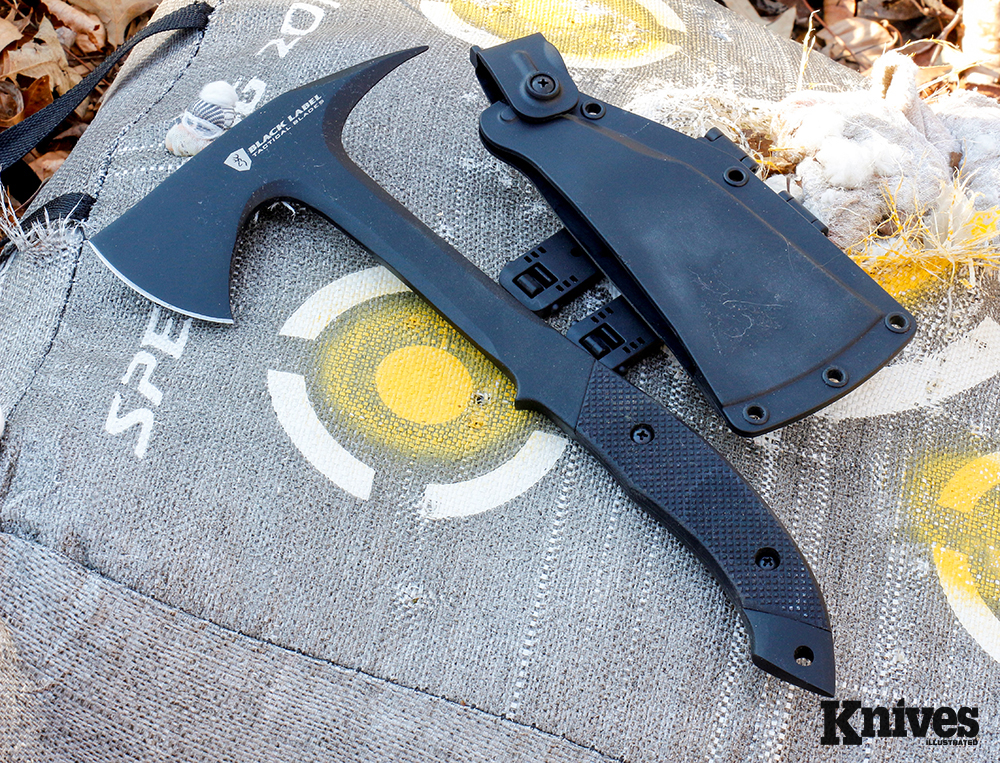
This early model of the Browning Shock ‘N Awe Tomahawk is an example of a small, all-steel ‘hawk that can do double duty in tactical and bushcraft applications.
HEAVY-DUTY CHOPPING TOOLS
In the Northeast where I spend most of my time, a hatchet or tomahawk makes the most sense. But if your jungle is really a jungle and your chopping tool must perform heavy brush-clearing duties too, then a machete might be a wiser choice. There are new designs being offered every year.
For my purposes, I haven’t found anything significantly better than the Ontario 1-18 Military Machete. Ontario has been making this model to military specs for more than 60 years.
It’s available with either a plain or sawback spine. The 18-inch carbon steel blade has a zinc-phosphate finish. The plastic handle is smooth and not as likely to raise blisters. The grip has a hand-stop at the butt end, and I like that.
There’s a lanyard hole too. I shouldn’t have to say this, but don’t wrap a lanyard around your wrist when swinging any chopping tool. Lose your grip and the blade will swing right back at you like a pendulum with usually disastrous results.
MANY, MANY MORE
There are so many workable designs out there at every price point from some very good makers. I apologize if I haven’t mentioned your favorite.
One thing’s for sure: Pick up a good chopping tool kit, put it through some hard work, and you’ll forget about the if-I-only-had-one-knife debate, at least for a little while.
SOURCES
W.R. Case & Sons
CaseKnives.com
Cold Steel
ColdSteel.com
Estwing
Estwing.com
Columbia River Knife and Tool
CRKT.com
Gerber
GerberGear.com
Ontario Knife Company
OntarioKnife.com
SOG
SOGKnives.com
Browning
Browning.com
Editor’s note: A version of this article first appeared in the May/June 2021 print issue of Knives Illustrated.

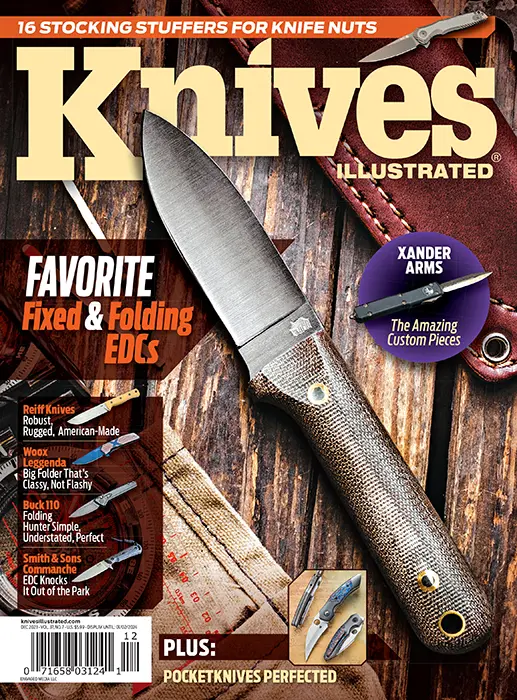 Subscribe / Back Issues
Subscribe / Back Issues